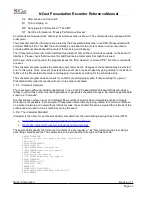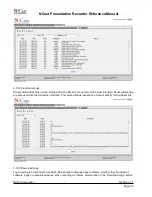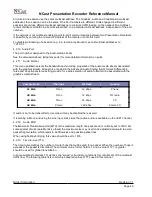
NCast Presentation Recorder Reference Manual
Resolution
Minimum Bit-rate
Preferred Bit-rate
QVGA (320x240)
128 kbps
192 kbps
VGA (640x480)
220 kbps
330 kbps
SVGA (800x600)
310 kbps
465 kbps
HD720 (1280x720)
550 kbps
800 kbps
Settings below these values will generate pixelation and other visual artifacts in the received image. Also,
use of the minimum bit-rates will increase end-to-end latency, may reduce the visual clarity of the image and
introduce lip-synch problems. As with any other type of compression system, there is a complex interaction
between bit-rate, frame-rate, image resolution, and end-to-end latency. For HD720 images, settings above
1000 kbps generally produce excellent results. The lowest latency is achieved by setting the bit-rate to the
maximum permitted, which is 5,000 kbps.
Reducing the bit-rate, frame-rate and resolution will allow older PCs operating at lower performance levels to
decode the received imagery without skips and stutters. For the full frame-rate and bit-rate at HD720
resolutions modern PCs in the 2 GHz.+ class are required.
For the lowest bit rate, 128 kbps, a resolution of 640x480 and a frame-rate of 5 frames/second for graphics
or 10 frames/second for video are recommended.
There is no way to define the optimum settings for a given application. It depends on the material being
presented, the expectations for motion smoothness and embedded video performance, the equipment
available to the receiving audience, the maximum network bandwidth available, and other factors. The only
way to determine the optimum settings for a particular installation is to run tests on the material being
presented using the network at hand.
4.2.7. Video Frame-rate
The video frame-rate represents the number of frame (visual image) grabs per second the system will
attempt to achieve. The range of this setting is 1-30 frames per second. For NTSC video encoding a full 30
frames/second is achieved.
At HD720 resolutions, dropping the frame rate to lower values (5 frames/second, for example) allows a
broader range of lower performance PCs to successfully decode the received presentations. It also reduces
the required network bandwidth. At these rates, however, cursor movements look somewhat jerky and
embedded video clips do not play well. One tradeoff might be to send a lower resolution (SVGA, 800x600)
image at a higher frame-rate.
At settings of 10 frames/second cursor movement and drop-down menus look natural, but video still suffers.
At 15 frames/second video playback starts to become acceptable, but high-motion imagery has detectable
artifacts. At the higher rates of 20 frames/second and up both the video and graphics performance look
natural. These high frame-rates deliver smooth animation and video playback that most viewers will find
acceptable.
4.2.8.
Video MTU
The Maximum Transmission Unit (MTU) is the maximum length of a packet and is normally set to 1500. For
some special circuits (satellite links, others) the maximum size may need to be adjusted downward to avoid
packet fragmentation, which leads to inefficiencies and possible packet loss.
4.2.9. Audio Address
An address entered for Audio (the Audio media stream) will be either a valid multicast address, or the
numeric host IP address of the remote unit if a point-to-point connection is being established.
For a discussion of multicast addresses, see the discussion above (Graphics addresses).
NCast Corporation
Revision 1.1
Page 45
















































